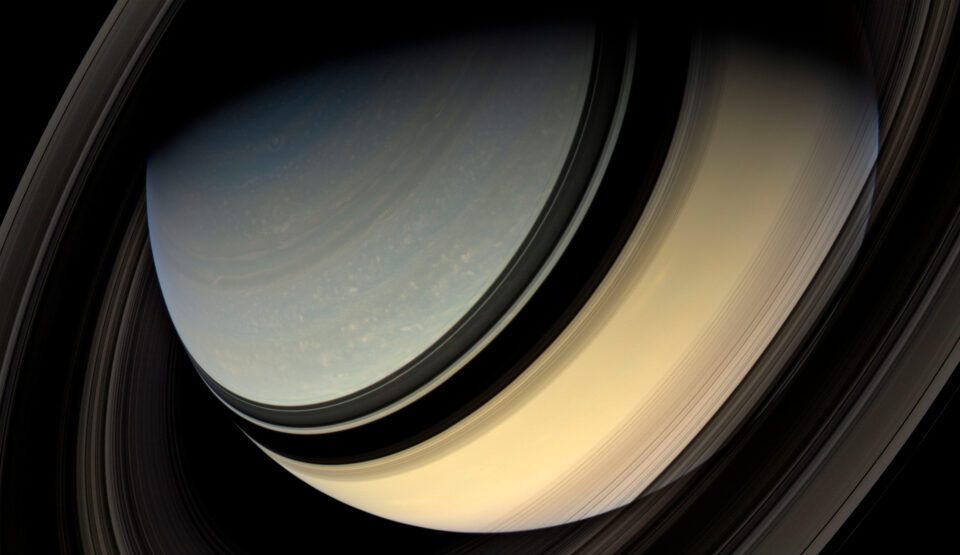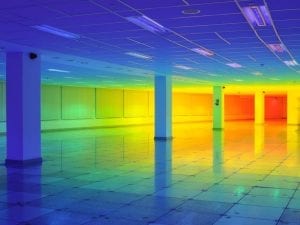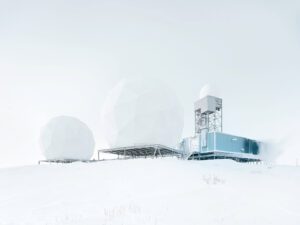Otherworlds: Visions of Our Solar System at The Natural History Museum, London, will explore the beauty of our solar system and demonstrate that the visual legacy of six decades of space exploration constitutes a visually stunning, important chapter in the history of photography. Raw data provided by the National Aeronautical and Space Administration (NASA) and European Space Agency (ESA) missions has been painstakingly processed and assembled for public display, alongside an accompaniment original music by Brian Eno. Created by artist, curator and writer Michael Benson, the 77 composite images on display represent a joining together of art and science. We speak with Benson about the exhibition.
A: While some of these landscapes look distinctly alien, they also have parallels with scenery closer to home – do you feel that we always attempt to project the familiar onto the unknown as a means of making sense of the world?
MB: This is really an excellent question, and gets to the heart of one of my motivations in working with these images. Because of course it’s always a two way game, meaning the unfamiliar also has an impact on one’s evaluation of the local. So there’s an element of revelation, of discovery, in working with these images, and it can be very personally gratifying and enriching. I look at my terrestrial surroundings in a way informed by how our extraterrestrial ones look, and also by how our world looks from the outside.
A friend of mine, Chris Rose, who teaches at the Rhode Island School of Design, and I were talking not too long ago about the surreal effect Stanley Kubrick achieved in putting his Odysseus-astronaut, Dave Bowman, into a Louis XIV hotel room at the conclusion of the hyperkinetic “trip” part of the film 2001: A Space Odyssey. Chris linked this to the experience of the first British expeditions to Australia in the 18th century. Recall that James Cook was so impressed by the amount of vegetation in one anchorage that he named it Botany Bay, and designated it as ideal for settlement. But actually he was seeing, in effect, the rolling green hills of England in his mind’s eye. There was no awareness of indigenous Australian conditions; how could there be? The alien continent had its own rhythms, and when a later expedition showed up 18 years later, with its cargo of convicts, the land was quickly deemed unsuitable for habitation. So yes, we see what we know, at least initially. And that’s part of what Kubrick may have been getting at in suddenly putting his traveller into an extraterrestrial hotel room.
In the end after doing much work with these planetary images, I see our world as part of a Solar System-wide continuity. We’re one in a series of wheeling landscapes, all lit by the same source and anchor-point, the Sun. We belong to an archipelago.
A: Science has a significant influence on contemporary art, and certain forms of multimedia art could be said to influence the sciences in turn – particularly those with a futuristic vision that make use of new technologies. Which would you say has played a greater role in Otherworlds?
MB: You know it’s interesting, I’ve given the matter some thought, and I don’t see a serious impact or major influence on science by art. Though I suppose you could make the case that the recent film The Martian is a kind of feature-length argument for funding NASA. And if that works out — then by all means — science has indeed been impacted by art. But it’s questionable.
While the history of technology is influenced by where the money is going in the entertainment sphere, that’s not the same thing. I think though science may look with due regard on art, it operates according to a very different methodology, and scientists really risk being disrespected by their peers if they attempt to incorporate aesthetic impulses or artistic methodologies in their work. So I disagree with that part of the question.
But of course I agree that science as the reigning force dominating western culture has had a profound impact on the arts. This is true in technology-based art but also in more traditional art. How could it not? It’s in the air we breathe, literally. It has enabled some art forms as well, of course. Photography and filmmaking for example were the end result of centuries of research into the physics of optics and the development of an understanding of chemistry, etcetera. Astronomer John Herschel was at the forefront of research into photography in the mid-19th century. So astronomy and photography are in effect co-conspirators.
As to how my work with planetary images is influenced by science, it needs to be said that it wouldn’t have been possible in the first place without the massive scientific-technical effort behind the great exploratory missions to the planets that took place over the last six decades. All of my work with planetary images is a form of détournement, a repurposing of material intended for scientific research, and making the argument that it belongs to the domain of photography and visual representation, whatever its undoubted role in the history of science. Only unlike with the Situationists or the Letterists, this form of hijacking, or to take the word literally, re-routing, isn’t about creating political scandals. Though I would argue it does have an ethical, even a political dimension. So Otherworlds, and my previous planetary projects Beyond and Planetfall, are making the case that the visual legacy of 60 years of planetary exploration constitutes a significant chapter in the history of photography — and indeed all visual representation, extending back to Lascaux and Chauvet. And they’re also suggesting, I suppose, that we would do well to look up occasionally from our rather self-absorbed terrestrial concerns, and take in the wider picture. I mean, we have rather startling new information concerning our context in the universe.
But to return to your question about science and art, there’s a deeper back-story, alluded to above, concerning the development of an understanding about how visual phenomena can be reproduced using mechanical — technological — means. And by the way you could make the case that the history of technology itself is grounded and rooted in the perceived need to reproduce celestial movement mechanically on Earth — to replicate untouchable celestial motion in tangible materials here on Earth. In the form of astronomical clocks, for example, which were simplified across centuries and became the time-pieces we used to wear on our wrists, but which of course have now largely migrated to our phones. The analogue watch face is a simplification of the design of the solar system. And the effort behind miniaturising it is at the wellspring (or maybe ‘mainspring’) of all the technologies we deploy on an hourly basis in the 21st century.
So in effect the heavens reached down and had their way, and all technology has at its root a replication of and celebration of the motions of the spheres. And so these missions to the planets are in effect a return to the source. The technologies that enable me to unlock these images from the planetary science archives where they’ve been housed, largely in obscurity, are also implicated in this story: the hardware and software, the image processing tools.
A: Each photograph is incredibly detailed and beautifully composed, a real visual spectacle. What is it about these landscapes that fascinates you personally?
MB: Well it’s interesting that you ask that right now, because under deadline pressure from my upcoming show, I’ve been doing quite a bit of new image processing. And so just this week I spent two days constructing an image of Jupiter from raw image data from the then-Saturn-bound Cassini spacecraft. And so I had plenty of opportunity to examine the largest planet in the Solar System in great detail again. And you know, it really is the most extraordinary visual spectacle, as you put it. Somehow the Ancients intuited that Jupiter, which for them was just a wandering point of light in the sky, should be named after the king of the gods. And when we finally got there centuries later, via our camera-bearing avatars, it really lived up to its name. To begin with, it has that stunningly vast, kinetic and impressive storm system, the Great Red Spot, a spinning vortex which in effect stares across the solar system like a huge eye. It’s an elliptical hurricane that we’ve known about for over three centuries, and it’s three times the size of Earth. And then there are all the counter-rotating bands of atmosphere, which abrade against each other, producing other fascinating whorls of turbulent tan and reddish-beige, and spinning off other giant kinetic storm systems as well. It’s really a staggering sight, one of the great displays of pyrotechnics in nature.
And then there’s Saturn, with its ravishing rings — one of the most sublime objects ever produced by nature. We’re lucky to have such a planet in the Solar System. You know, we’ve only had the capability to see such distant worlds up close for a few decades, and then we’ve only managed to do so in fragmentary glimpses. So part of my motivation is to pan through the visual record, and assemble those glimpses, and transmit my own personal fascination with these objects by using individual spacecraft frames to produce mosaic composite vistas. (And thanks for saying that they may occasionally live up to their subjects, at least in a small way.)
A: Do you feel that it is important to make relatively unseen photographs of space exploration more accessible to the general public?
MB: Well as I alluded to a bit above, I think there’s an ethical dimension to getting these images out there, and even an ideological one, in the sense that we really are a very self-absorbed species, to the exclusion (for example) of much consideration of the impact of our actions on our own world. Though as the temperature continues to spike I think we’re coming round to the understanding that this must change. But in any case we seem woefully engrossed in our own dismal squabbles all the time, with a ridiculous amount of our collective wealth spent on weapons systems, and our attention always on the next scandal, all of it at the expense of a wider view. We should really think about our context a bit more, as a form of life entirely reliant on the very limited dry-and-temperate areas on the surface of a very small, circumscribed sphere suspended in an exceedingly vast space — possibly even a limitless space, though the distinction is without a difference, considering our diminutive scale in the order of all things.
It took the views of Earth from the Moon in the late 1960s and early 1970s to help launch the environmental movement. I’ll also admit to being not unsusceptible to some of the ideas developed during the utopian projective phase prior to the so-called Space Age, ideas for example associated with the early 20th century Russian philosophy known as “Cosmism.” A core precept of Cosmism was best articulated by one of its leading figures, Konstantin Tsiolkovsky, who made the famous programmatic remark that “Earth is the cradle of the mind, but humanity can’t remain in its cradle forever.” I can get behind that. By the way I’m happy to say that over the last few months I’ve managed to produce several of the largest, most detailed color views of Earth that I believe have yet been made. They’re based on black and white geostationary weather satellite images, with color data provided from other sources. I’m printing them at 72 x 72 inches. At that scale, you really see the world as a unitary system, as an extraordinary unitary environment. There are three of that size in the Otherworlds show.
But in general I don’t want to attempt to assign specific meanings to these images, because I’d like to think they speak volumes by themselves, and probably have different meanings depending on who looks at them. And you know, part of their appeal — the appeal of Jupiter’s gargantuan stormy bulk, or of Saturn’s serene flawless ring system, or of the serrated deserts of Mars — is their cryptic, powerful sense of ambiguity. They really are profoundly mysterious, on every level.
Otherworlds: Visions of Our Solar System, 22 January – 15 May 2016, The Natural History Museum, Cromwell Road London SW7 5BD.
Discover more at www.nhm.ac.uk.
Follow us on Twitter @AestheticaMag for the latest news in contemporary art and culture.
Credits
1. Saturn. NASA/SDO/GSFC/Michael Benson, Kinetikon Pictures. Courtesy of Flowers Gallery.





